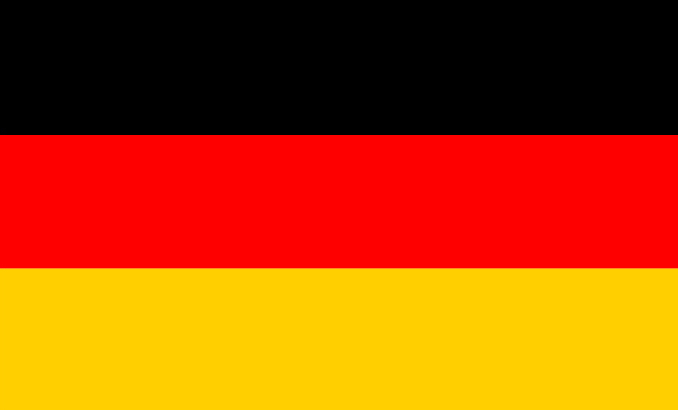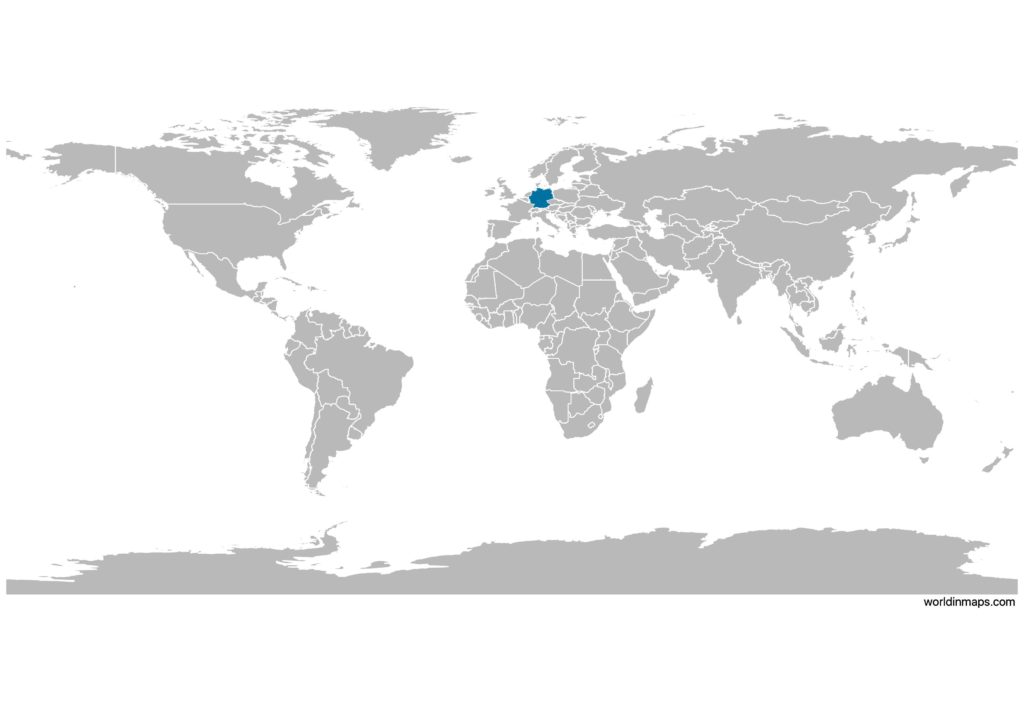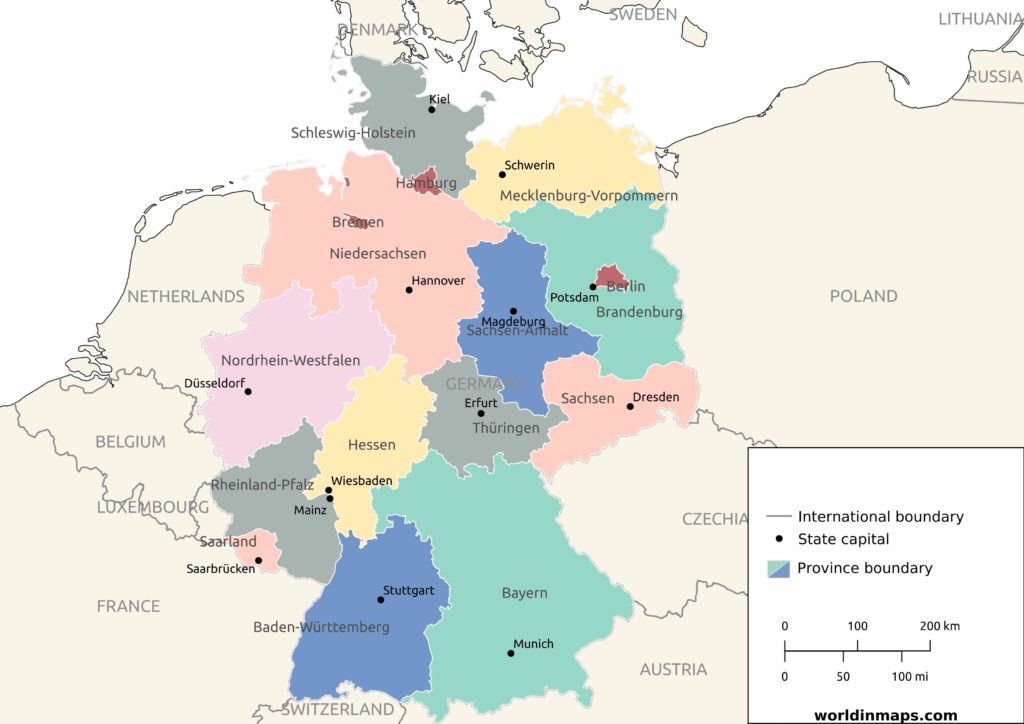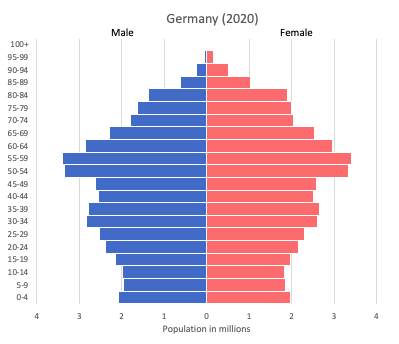Germany

| Government | |
| Name | Federal Republic of Germany |
| German | Bundesrepublik Deutschland |
| Government type | Federal parliamentary republic |
| Capital | Berlin (3,644,826 (2018)) |
| Currency | Euro (EUR) |
| People | |
| Population (2020) | 83,783,945 (19th) |
| Density of population | 232 P/km2 (58th) |
| Nationality | German |
| Official languages | |
| German | |
| Ethnic groups (2017) | |
| German | 87.2% |
| Turkish | 1.8% |
| Polish | 1% |
| Syrian | 1% |
| Other | 9% |
| Religions (2018) | |
| Roman Catholic | 27.7% |
| Protestant | 25.5% |
| Muslim | 5.1% |
| Orthodox | 1.9% |
| Other Christian | 1.1% |
| Other | 0.9% |
| None | 37.8% |
| Life expectancy (2020) | |
| Male | 78.7 years |
| Female | 83.6 years |
| Total population | 81.1 years (37st) |
| Homicides | |
| Total (2018) | 0.9 (143rd) |
| Geography | |
| Land area | 348,672 km2 |
| water area | 8,350 km2 |
| total area | 357,022 km2 (64th) |
| Mean elevation | 263 m |
| Lowest point | |
| Neuendorf bei Wilster | -3.5 m |
| Highest point | |
| Zugspitze | 2,963 m |
| Land use (2011) | |
| Agricultural land | 48% |
| Arable land | 34.1% |
| Permanent crops | 0.6% |
| Permanent pasture | 13.3% |
| Forest | 31.8% |
| Other | 20.2% |
| Urbanization | |
| Urban population (2020) | 77.5% |
| Rate of urbanization | 0.27% annual rate of change (2015 – 2020) |
| Economy | |
| Labor force (2017) | 45.9 million (14th) |
| Labor force by occupation (2016) | |
| Agriculture | 1.4 |
| Industry | 24.2% |
| Services | 74.3% |
| Unemployment rate (2017) | 3.8% (46th) |
| GDP (PPP) (estimate 2019) | |
| Total | $4.444 trillion (5th) |
| Per capita | $52,559 (16th) |
| GDP (nominal) (estimate 2019) | |
| Total | $3.863 trillion (4th) |
| Per capita | $46,653 (16th) |
| GDP by sector (estimate 2017) | |
| Agriculture | 0.7% |
| Industry | 30.7% |
| Services | 68.6% |
| Exports (2017) | $1.434 trillion (3rd) |
| Exports partners (2017) | |
| US | 8.8% |
| France | 8.2% |
| China | 6.8% |
| Netherlands | 6.7% |
| UK | 6.6% |
| Italy | 5.1% |
| Austria | 4.9% |
| Poland | 4.7% |
| Switzerland | 4.2% |
| Imports (2017) | $1.135 trillion (3rd) |
| Imports partners (2017) | |
| Netherlands | 13.8% |
| China | 7% |
| France | 6.6% |
| Belgium | 5.9% |
| Italy | 5.4% |
| Poland | 5.4% |
| Czechia | 4.8% |
| US | 4.5% |
| Austria | 4.3% |
| Switzerland | 4.2% |
Germany on the world map

Germany is a country in Central and Western Europe. It lies between the North Sea and the Baltic sea to the north and the Alps to the south.
Germany has 9 neighboring countries. It borders the Netherlands, Belgium, Luxembourg and France to the west, Switzerland and Austria to the south, the Czech Republic and Poland to the east and finally Denmark to the north.
German states map

Germany, officially the Federal Republic of Germany, is a federal state of sixteen partly sovereign federated states (German: Bundesland (singular) / Bundesländer (plural)).
Berlin, Hamburg and Bremen are called Stadtstaaten (city-states) because they consist of only one city (2 for Bremen: Bremen and Bermerhaven).
The Thirteen other states are called Flächenländer (area states).
The 16 german states and their population
| State | Capital | Area (km ²) | Population (2019) | Pop. / km² |
|---|---|---|---|---|
| Baden-Württemberg | Stuttgart | 35,752 | 11,100,394 | 310 |
| Bavaria (Bayern) | Munich (München) | 70,552 | 13,124,737 | 185 |
| Berlin | Berlin | 892 | 3,669,491 | 4,086 |
| Brandenburg | Potsdam | 29,479 | 2,521,893 | 85 |
| Bremen | Bremen | 419 | 681,202 | 1,630 |
| Hamburg | Hamburg | 755 | 1,847,253 | 2,439 |
| Hesse (Hessen) | Wiesbaden | 21,115 | 6,288,080 | 297 |
| Lower Saxony (Niedersachsen) | Hanover (Hannover) | 47,609 | 7,993,448 | 168 |
| Mecklenburg-Vorpommern | Schwerin | 23,180 | 1,609,675 | 69 |
| North Rhine- Westphalia (Nordrhein-Westfalen) | Düsseldorf | 34,085 | 17,932,651 | 526 |
| Rhineland-Palatinate (Rheinland-Pfalz) | Mainz | 19,853 | 4,084,844 | 206 |
| Saarland | Saarbrücken | 2,569 | 990,509 | 386 |
| Saxony (Sachsen) | Dresden | 18,416 | 4,077,937 | 221 |
| Saxony-Anhalt (Sachsen-Anhalt) | Magdeburg | 20,446 | 2,208,321 | 108 |
| Schleswig-Holstein | Kiel | 15,799 | 2,896,712 | 183 |
| Thuringia (Thüringen) | Erfurt | 16,172 | 2,143,145 | 133 |
Germany top 10 largest cities (2018)
- Berlin (3,644,826)
- Hamburg (1,841,179)
- Munich (1,471,508)
- Cologne (1,085,664)
- Frankfurt (753,056)
- Stuttgart (634,830)
- Düsseldorf (619,294)
- Leipzig (587,857)
- Dortmund (587,010)
- Essen (583,109)
Demography
Population pyramid

Age structure data
Estimate for 2020:
- 0-14 years: 12.89% (male 5,302,850/female 5,025,863)
- 15-24 years: 9.81% (male 4,012,412/female 3,854,471)
- 25-54 years: 38.58% (male 15,553,328/female 15,370,417)
- 55-64 years: 15.74% (male 6,297,886/female 6,316,024)
- 65 years and over: 22.99% (male 8,148,873/female 10,277,538)
Remark: the age structure of a population affects a nation’s key socioeconomic issues. Countries with young populations (high percentage under age 15) need to invest more in schools, while countries with older populations (high percentage ages 65 and over) need to invest more in the health sector. The age structure can also be used to help predict potential political issues. For example, the rapid growth of a young adult population unable to find employment can lead to unrest.
Population from 1950 to 2020
Source: United Nations, Department of Economic and Social Affairs, Population Division (2019). World Population Prospects 2019, Online Edition. Rev. 1.
Evolution of the life expectancy from 1960 to 2018
Source: World Development Indicators, The World Bank
Major rivers in Germany
| Rank | Name | Length in Germany | Total length |
|---|---|---|---|
| 1 | Rhine | 865 km (537 mi) | 1230 km (764 mi) |
| 2 | Elbe | 727 km (451 mi) | 1,112 km (691 mi) |
| 3 | Danube | 647 km (402 mi) | 2,850 km (1,770 mi) |
| 4 | Main | 525 km (326 mi) | 525 km (326 mi) |
| 5 | Weser | 452 km (281 mi) | 452 km (281 mi) |
| 6 | Saale | 413 km (257 mi) | 413 km (257 mi) |
| 7 | Spree | 382 km (237 mi) | 382 km (237 mi) |
| 8 | Neckar | 362 km (225 mi) | 362 km (225 mi) |
| 9 | Ems | 362 km (225 mi) | 362 km (225 mi) |
| 10 | Havel | 325 km (202 mi) | 325 km (202 mi) |
Economy
Agriculture:
potatoes, wheat, barley, sugar beets, fruit, cabbages; milk products; cattle, pigs, poultry
Industries:
among the world’s largest and most technologically advanced producers of iron, steel, coal, cement, chemicals, machinery, vehicles, machine tools, electronics, automobiles, food and beverages, shipbuilding, textiles
Exports – commodities:
motor vehicles, machinery, chemicals, computer and electronic products, electrical equipment, pharmaceuticals, metals, transport equipment, foodstuffs, textiles, rubber and plastic products
Imports – commodities:
machinery, data processing equipment, vehicles, chemicals, oil and gas, metals, electric equipment, pharmaceuticals, foodstuffs, agricultural products
Time zone and current time in Germany
Go to our interactive map to get the current time in Germany